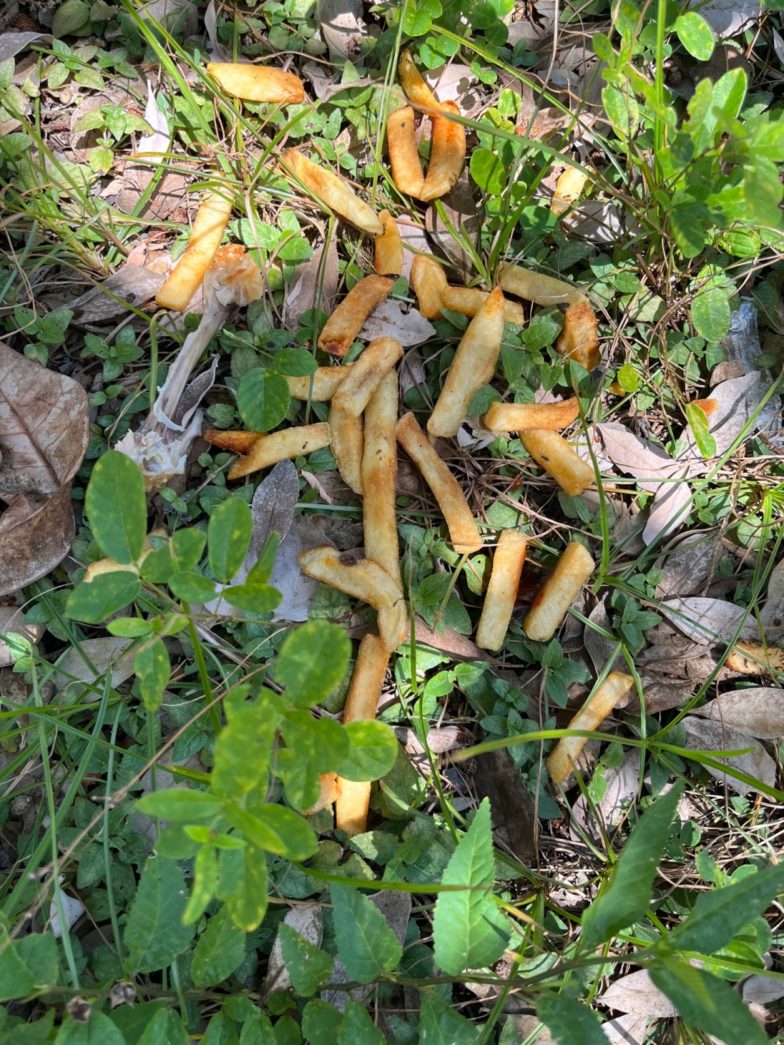My beautiful boy lay panting on the floor of the examining room, eyes glazed and unfocused. When the emergency vet bent down and greeted him, he could barely wag his tail. But he did.
“I think he’s stoned,” the vet announced. We told him Winston had suddenly stopped in his tracks on Duval Street while walking back from the Green Parrot with my husband. Unable to move, he had to be picked up and carried home, all 60 pit-boxer pounds of him.
“People throw all kinds of things on the ground around there,” the vet said. “He could have lapped up a roach in melted ice cream. Or nacho sauce. Whatever.”
As it turned out, Winston wasn’t stoned. It was much more serious than that. So serious I’ll save that for another story.
But his comment alerted me to the food-rigged minefield that is Key West for dogs and their people. Winston, Ozzy’s predecessor, really wasn’t all that interested in sniffing out food unless it was in his face. But Ozzy’s mission in life (besides chasing lizards), is to find more interesting fare than the kibble and yogurt he’s subjected to at home. He starts his “search and eat” operation as soon as he leaves the gate.
That means wherever we walk, I’m constantly scanning the ground, hoping to find food before he does. I’m never entirely successful. A short list of what he’s gotten into his mouth includes: burger patties without buns, buns without burger patties, half-eaten pizza slices, melted Key lime pie. A whole cooked pork chop.
And chicken bones. Lots of them.
I first became aware of the dangers of chicken bones on the island one month after moving to Old Town. I was walking Ozzy around the lush grounds of the Harvey Government Center when he snatched up a half-eaten thigh bone. I tried my usual, self-taught way of getting food out of a dog’s mouth, jamming my hand in and trying to force the jaws open. This always worked well with my former dogs, who were much larger and stronger than this one. (Once, I even got my lab/rottweiler to release a stiffened dead squirrel.) But I was no match for a poodle with a short, sharp snout and dug-in stubbornness. We fought and I finally got the bone, although he managed to swallow some of it. Thank goodness, it went down the hatch without choking him.
The next time we walked past, I kept off the lawn, but Mr. Sniffy found another chicken bone, this time on the sidewalk. The following week, I walked him across the street. That’s when I noticed people sitting in front of the Harvey Center eating lunch. Across the street from that was an Exxon with a Dion’s Quik Chik.
Mystery solved. All I had to do was keep a safe distance between us and a Dion’s. But no matter where we walked, the bones appeared and Ozzy found them.
I became a woman obsessed. Who or what was spreading these chicken bones around the island? I had to know.
At first, I thought hawks or vultures might be involved, swooping down from above and dropping bones in the middle of nowhere. Then I found out that while raptors are attracted to good, meaty leftovers like chicken, they’re seasonal visitors to the Keys and not around long enough to be the main source of the traveling bones.
A quick Google search led to a surprising suspect: cats. Apparently cats have a long history of enjoying bird bones and are much better suited to eat them than dogs. Key West has a large and bold population of feral and outdoor kitties. Could it be that cats were picking up the bones and dropping them around the island so dogs would choke on them? I’m joking of course. (Right, cats?).
To find the real culprit, I had to think outside the litter box. And when I did, the answer was obvious. Chicken bones were everywhere because fried chicken outlets were all over this island: Dion’s (three locations), Publix (two), Winn-Dixie Deli, Popeyes and Wingmasters. That’s eight altogether. All mainly “carry out.” And guess who is carrying them out?
People. People who eat as they walk down the sidewalk or work outside or drive through town munching on their three-piece fried chicken dinner before tossing bones onto the street (or out the car window) like cavemen at a picnic. As if it’s no big deal.

It is a big deal for dogs and the people who love them. Chicken bones splinter easily and can tear the throat or puncture a dog’s intestines. They can also lead to choking and air obstruction. If that happens, it’s off to the vet you go.
Your first instinct when a dog snatches a chicken bone is to get it out. But according to experts, sticking your hand in their mouth and yelling “let go” (as I have) is not a good idea. Yelling can cause the dog to panic and try to swallow the bone quickly rather than give it back to you. Instead, the advice is to keep calm. Offer a high-value treat to entice them to drop the bone. By “high value” we’re talking real meat here, people, something like beef jerky, dried liver or bacon (the dog owner’s secret weapon).
No self-respecting dog will give up a chicken bone for a dog biscuit.
Of course, teaching your dog to “leave it” is the best way to keep them from picking it up. But dogs can be dogs and will grab food without warning. As for “leaving it,” I can’t even get Ozzy to give up a sock easily.
I’ve got an idea. What if the folks who keep tossing their garbage on the streets would just “leave it?” In a trash can.

























